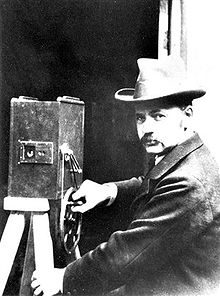James Williamson (film pioneer)
James A. Williamson (born November 8, 1855 in Pathhead near Kirkcaldy , Scotland , † August 18, 1933 in Richmond ) was a British film pioneer.
Live and act
James Williamson grew up in Edinburgh and trained as a druggist in London . From 1877 he lived in Eastry in Kent , where he married and ran a drugstore until 1886. He then moved to Hove near Brighton . In his local drugstore he traded articles for photographers and was enthusiastic about photography himself. In 1894 he began to experiment with film, in 1896 he bought a film projector, which he converted a year later into a film camera with which he began making his own films.
In 1898 he gave up his drugstore and devoted himself exclusively to filming. In 1900 he shot a " topicality film " in a backyard in Hove about the boxer rebellion in China , Attack on a China Mission Station , which already contained counter cuts and parallel plots. Williamson's film Stop Thief and Fire! from 1901 are among the earliest examples of films in which a story is told in several shots with the help of the invisible cut . Stop Thief is considered to be the first film to show a car chase . In Fire! Williamson described the discovery and fighting of a house fire in elaborate settings. The film is believed to be the inspiration for Edwin S. Porter's Life of an American Fireman , one of the first narrative films in the United States. As a leading member of the “ School of Brighton ” Williamson thus contributed to the development of narrative techniques in the young medium of film.
In the fall of 1902, James Williamson founded the Williamson Kinematographic Company in Brighton and made up to 50 films a year. The Little Match Seller (1902, the little girl with the sulfur sticks ), a strip of 64 meters and 3.5 minutes, is considered the first film adaptation of a story by Hans Christian Andersen . From 1907 he distributed his films, which he always cast with family members, himself.
In 1909 Williamson, meanwhile one of the leading film producers in Europe, took part in the first congress of film producers in Paris . In the same year he gave up the production of feature films . In the following years he worked on documentary films for science and moved his work to London. There he began developing special cameras for scientific and military use. James Williamson died in Richmond near London in 1933.
Filmography (selection)
- 1898: Two Naughty Boys Upsetting the Spoons
- 1899: The Jovial Monks Washing the Sweep
- 1899: Highland Fling Clever Cricket
- 1900: Attack on a China Mission
- 1901: The Big Swallow
- 1901: Stop Thief!
- 1901: Fire
- 1902: A Reservist before the War and after the War
- 1902: The Little Match Seller
- 1903: The Deserter
- 1905: Two Little Waifs
- 1906: Our New Errand Boy
- 1907: The Brigand's Daughter
- 1909: Tower of London
literature
- Hauke Lange-Fuchs: The Ugly Duckling and other film stories. Hans Christian Andersen in the film . Documentation, Nordic Film Days Lübeck 1999; Pp. 40-42
- Martin Sopocy, James Williamson: Studies and Documents of a Pioneer of the Film Narrative . Fairleigh Dickinson University Press 1998
Individual evidence
- ^ Robert Pearson: Early Cinema . In: The Oxford History of World Cinema , Oxford University Press, Oxford 1996. ISBN 0-19-874242-8 , p. 19.
- ^ Jean Mitry: The Aesthetics and Psychology of the Cinema . Indiana University Press, Bloomington 1999, ISBN 0-253-21377-0 , p. 94.
- ^ Charles Musser: Before the Nickelodeon: Edwin S. Porter and the Edison Manufacturing Company . University of California Press, Berkeley 1991, ISBN 0-520-06986-2 ; P. 219.
- ↑ Hauke Lange – Fuchs (1999), p. 40
Web links
- James Williamson in the Internet Movie Database (English)
- Who's Who of Victorian Cinema : James Williamson (English)
- Brighton and Hove : James Williamson (English)
- The Little Match Seller (1902)
- Our New Errand Boy (1906)
| personal data | |
|---|---|
| SURNAME | Williamson, James |
| ALTERNATIVE NAMES | Williamson, James A. |
| BRIEF DESCRIPTION | British film pioneer |
| DATE OF BIRTH | November 8, 1855 |
| PLACE OF BIRTH | Pathhead at Kirkcaldy , Scotland |
| DATE OF DEATH | August 18, 1933 |
| Place of death | Richmond |

